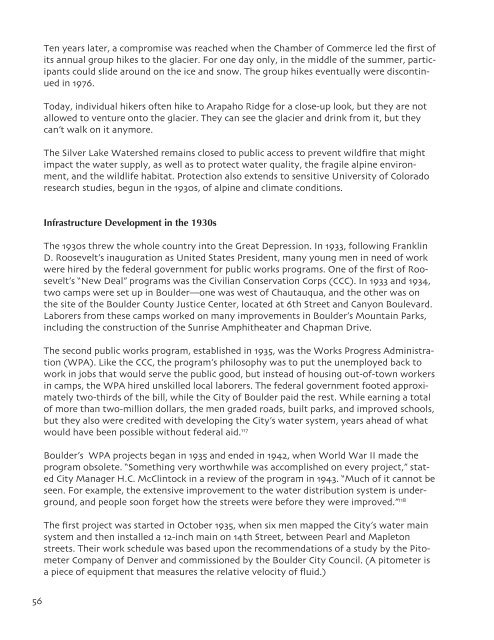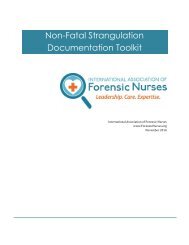Create successful ePaper yourself
Turn your PDF publications into a flip-book with our unique Google optimized e-Paper software.
Ten years later, a compromise was reached when the Chamber of Commerce led the first of<br />
its annual group hikes to the glacier. For one day only, in the middle of the summer, participants<br />
could slide around on the ice and snow. The group hikes eventually were discontinued<br />
in 1976.<br />
Today, individual hikers often hike to Arapaho Ridge for a close-up look, but they are not<br />
allowed to venture onto the glacier. They can see the glacier and drink from it, but they<br />
can’t walk on it anymore.<br />
The Silver Lake Watershed remains closed to public access to prevent wildfire that might<br />
impact the water supply, as well as to protect water quality, the fragile alpine environment,<br />
and the wildlife habitat. Protection also extends to sensitive University of Colorado<br />
research studies, begun in the 1930s, of alpine and climate conditions.<br />
Infrastructure Development in the 1930s<br />
The 1930s threw the whole country into the Great Depression. In 1933, following Franklin<br />
D. Roosevelt’s inauguration as United States President, many young men in need of work<br />
were hired by the federal government for public works programs. One of the first of Roosevelt’s<br />
“New Deal” programs was the Civilian Conservation Corps (CCC). In 1933 and 1934,<br />
two camps were set up in Boulder––one was west of Chautauqua, and the other was on<br />
the site of the Boulder County Justice Center, located at 6th Street and Canyon Boulevard.<br />
Laborers from these camps worked on many improvements in Boulder’s Mountain Parks,<br />
including the construction of the Sunrise Amphitheater and Chapman Drive.<br />
The second public works program, established in 1935, was the Works Progress Administration<br />
(WPA). Like the CCC, the program’s philosophy was to put the unemployed back to<br />
work in jobs that would serve the public good, but instead of housing out-of-town workers<br />
in camps, the WPA hired unskilled local laborers. The federal government footed approximately<br />
two-thirds of the bill, while the City of Boulder paid the rest. While earning a total<br />
of more than two-million dollars, the men graded roads, built parks, and improved schools,<br />
but they also were credited with developing the City’s water system, years ahead of what<br />
would have been possible without federal aid. 117<br />
Boulder’s WPA projects began in 1935 and ended in 1942, when World War II made the<br />
program obsolete. “Something very worthwhile was accomplished on every project,” stated<br />
City Manager H.C. McClintock in a review of the program in 1943. “Much of it cannot be<br />
seen. For example, the extensive improvement to the water distribution system is underground,<br />
and people soon forget how the streets were before they were improved.” 118<br />
The first project was started in October 1935, when six men mapped the City’s water main<br />
system and then installed a 12-inch main on 14th Street, between Pearl and Mapleton<br />
streets. Their work schedule was based upon the recommendations of a study by the Pitometer<br />
Company of Denver and commissioned by the Boulder City Council. (A pitometer is<br />
a piece of equipment that measures the relative velocity of fluid.)<br />
56



